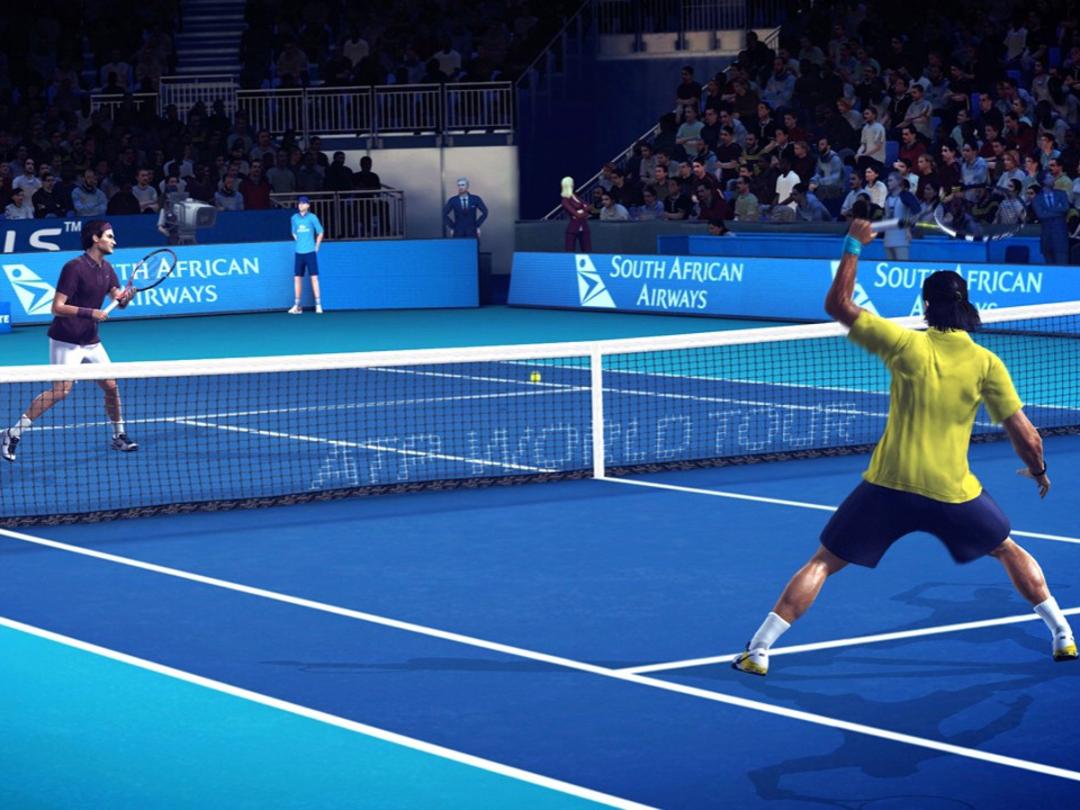The 10 best tennis video games ever made to play during Wimbledon
Fancy whacking a ball around without getting off the sofa? Try these tennis video game classics, plucked from the dawn of gaming to the modern day

Anyone for tennis? If Wimbledon’s got you in the mood, but you’re terrible at racket sports, don’t despair. Thanks to video games, you can take out your frustrations on everything from a white rectangle to uncanny valley takes on famous tennis superstars. So limber up for a breakneck tour through the entire history of a genre, with Stuff’s 10 best tennis video games ever made. They’ll be sure to make any true tennis fan grunt with delight.
1) Tennis for Two (1958, Donner Model 30 analog computer)
Proving video games will show up wherever they possibly can, American physicist William Higinbotham subverted a machine designed for calculating ballistic missile trajectories, using its oscilloscope to display the path of a ball and a side-on tennis court (ie two lines). A pair of controllers enabled players to time hits and adjust return angles.
At a lab visitor’s day, the game wowed, leaving other exhibits languishing in their inability to provide a basic abstraction of sport. A year later, Higinbotham upgraded the display (from five to 17 inches!), and added varying serve strengths and gravity effects, foreshadowing the games industry’s penchant for incremental upgrades and sequels.
2) Pong (1972, arcade)
Curiously, Pong is rarely emulated authentically, because the original hardware lacked a CPU or ROM. So you’ve likely played simulations rather than emulations over the years. Which probably doesn’t matter, given that the game itself was almost comically simple.
In fact, Pong seemed like a step back from Tennis For Two, with an abstraction of tennis that was even less realistic. The ball was square. The ball bounced off the court’s edges. But it was compelling, and so when Pong leapt from the arcades to cheap TV devices, it ushered in the age of home gaming. And it’s still worth a blast, due to its intuitive nature, the varying deflection angles and the ball getting faster the longer a rally goes on.
3) Match Point (1984, ZX Spectrum)
By the time of the home micro, programmers were ambitiously attempting to recreate sports in a somewhat realistic manner (given the limitations of the machines), but most of the tennis games were woeful.
Match Point bucked the trend, with a passable representation of a court and surprisingly fast gameplay. Although it only had a single ‘swing racket’ control, you could change the nature of your shots depending on when you hit the ball and provide extra power by striking it while moving forwards. You could say it was an 8-bit smash! (If you were into rubbish jokes.)
4) Super Tennis (1991, SNES)
We’re skipping forward a bit now, because most other retro-era tennis games were poor (Passing Shot!), weird (International 3D Tennis!) or just Match Point with prettier graphics.
In a sense, Super Tennis for the SNES initially resembled the last of those; but it soon became clear during play that if this game wasn’t made by Nintendo you’d be forgiven for thinking it a kind of proto-Virtua Tennis. You get plenty of shot types, arcade-oriented rallies, a touch of speech and even players desperately diving to make returns.
Be warned, though: Super Tennis has a demoralising take-no-prisoners approach to difficulty unless we’re getting old and losing our tennis-gaming skills – or just accurately mirroring what usually happens when an English player ventures on to a court.
5) Virtua Tennis (1999/2000, arcade and Dreamcast)
Virtua Tennis revolutionised tennis games in part through thumbing its nose to realism. Sega just did what Sega always does and transformed the sport into a breezy arcade experience, with speedy games, intuitive controls, and a selection of bizarre mini-games to help you train.
One minute, you’d be lobbing balls into drums; the next, you’re playing some kind of hybrid of ten-pin-bowling and tennis. There were also some truly terrifying representations of the tennis greats of the day, providing a glimpse into the first Wimbledon to occur after the zombie apocalypse.
6) Virtua Tennis 2 (2001, arcade and Dreamcast)
Controversy! With this entry, Sega either – depending on your opinion – took its game to an entirely new level, or repeatedly smashed its teeth out with a tennis racket.
New controls enabled you to slice, and new characters enabled you to do so as a woman, but play was significantly harder from the off. Still, a hugely ramped up year-based World Tour mode afforded a considerable amount of depth to anyone who wanted to spend a lot of time with the slightly less zombie-like roster of players.
7) Mario Power Tennis (2004/2005, GameCube)
Sega ramped up the arcade nature of tennis with Virtua, but in that area it pales in comparison to Nintendo’s efforts. On the N64, Mario Tennis naturally populated matches with the company’s roster of characters, controlled via an intuitive system that made rival games look comparatively bafflingly complex.
By its GameCube incarnation, Mario Power Tennis, the title had morphed into a kind of Pixar Nintendo Open – a vivid, vibrant hyper-real sport, full of dazzling colours, character-specific moves and courts (Wario Factory’s conveyer belts; Donkey Kong’s jungle level, with crocodiles wandering about) and blazing power shots.
8) Mario Tennis: Power Tour (2005, Game Boy Advance)
Presumably concerned Game Boy Color owners would throw their consoles out of the window if the company had the audacity to release a normal tennis game on the system, Nintendo crafted Mario Tennis to be closer to a quirky RPG that just happened to have tennis mechanics in place of a battle system.
For this Game Boy Advance sequel, the mash-up was particularly glorious, twinning amusing Zelda-like chats and exploration with high-octane ball-thwacking that was the best on the system. Add in furiously addictive madcap mini-games and you’ve a title that might not be tennis as you know it, but it does make everything else on this list seem a little dull by comparison.
9) Wii Sports (2006, Nintendo Wii)
As the Wii arrived, the games industry was roused by a million voices crying out in pain that Nintendo had – shock! – dumbed-down console gaming. Take the tennis bit of Wii Sports: players moved automatically, and you merely swung your controller a bit like a racket, only occasionally accidentally letting go and smashing your TV screen.
The thing is, it was fantastic (apart from the TV-smashing bit). Everyone could get in on the action, rather than having to first master the ‘gamepad claw’; yet there was enough nuance for dedicated players to pull off some fantastic moves – even if the little Mii characters looked ridiculous while doing so.
10) Top Spin 4 (2011, PS3/Wii/Xbox 360)
It’s probably sacrilege to say it, but some time in the 2000s, Sega lost its tennis-game crown; Virtua Tennis 3 was an impressive if predictable update, but its sequel was finally eclipsed by the lurking Top Spin series.
In Top Spin 4, the deep coaching system hugely added to the extensive career mode, and the character customisation went so far as to enable you to select different types of grunts and victory celebrations. It was perhaps all a little clinical (besides the bizarre uncanny valley player faces), but fluid player movement, balanced gameplay and detailed, responsive controls combined to make for a rewarding experience for those who persevered.
New balls, please
If you’re thinking, “Hang on. You’ve just recommended the game equivalents of Martina Navratilova, Andre Agassi and Roger Federer”, that’s because there are few newer titles capable of walloping an ace towards your console. Still, if you need something contemporary, there are two solid options.
Top Spin 2K25 (PS4, PS5, Xbox Series X/S, Xbox One, Windows) follows up on the last entry in the above list with an iterative effort that nets you a slew of licensed venues and players that look at least 34% less like zombies than they did in the Virtua Tennis days. Tweaked mechanics make for exciting risk vs reward moments during rallies. But you’ll grumble at the grind progression system and absurdist virtual currency, which leaves Wimbledon winners with barely enough extra virtual cash for a pair of virtual socks. Tsk.
Unsurprisingly, Nintendo Switch owners get something a mite more bonkers and colourful in the shape of Mario Tennis Aces. This builds on previous Nintendo efforts by fusing arcade gameplay and adventuring, while occasionally acknowledging that, yes, there’s a tennis game in there somewhere. Boss battles with tennis rackets can be entertainingly daft, although the single-player mode runs out of steam faster than the average Brit at Wimbledon. The game’s chaotic nature is fun while it lasts though.



